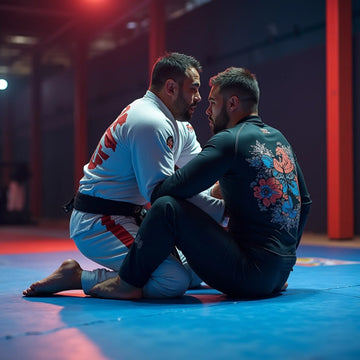Discover why a quality BJJ rash guard is your secret weapon on the mats—boost comfort, protect your skin, and amp up performance with the right fit and fabric.
What Is a BJJ Rash Guard?
At its simplest, a Brazilian jiu jitsu rash guard is a compression-style shirt or top meant to be worn under gis or alone for no-gi training. It’s typically made of tight, sweat-wicking fabrics—like polyester, nylon, and spandex blends—that cling to your body to prevent friction burns, rashes, and mat burns. Unlike a gi jacket, it offers little to no grip but excels at moisture management.
Honestly, it feels a bit like a superhero suit. When you slide under a strong guard or scramble across the mat, there’s no loose fabric to grab. Plus, the tight fit gives a mild compression benefit—keeping muscles warm and reducing fatigue.
Its roots go back to surfers and MMA pioneers who noticed skin irritation from wetsuits and mats. Over time, BJJ practitioners adopted the concept and refined it with panel stitching, seamless collars, and durable printing processes. That’s how our modern rash guards were born. They’ve become so essential that many academies now require one for both gi and no-gi training. Are rash guards required for BJJ? Technically, rules vary—but in most tournaments and gyms, they’re part of the dress code.
Benefits of Wearing a Rash Guard in BJJ
Slip one on, and you’ll notice almost immediately:
- Protection: Guards against mat burns, friction, and minor scrapes.
- Hygiene: Wicks sweat and prevents bacterial growth.
- Compression support: Stabilizes muscles, reducing soreness.
- Improved recovery: Keeps skin healthy, swapping irritation for comfort.
Here’s the thing: even if you’re rolling in a gi, your arms and neck can rub raw. A rash guard creates a barrier. You might also find that rash guards help you move more fluidly—materials stretch four ways, unlike rigid cotton gis.
Looking for style and function? Consider the Baphomet Seal Rash Guard—it’s designed to balance wicked graphics with reinforced seams.
Types of BJJ Rash Guards
BJJ rash guards come in several styles. Choosing the right one mostly depends on your training environment and personal taste.
| Style | Use Case | Advantages | Drawbacks |
|---|---|---|---|
| Short Sleeve | No-Gi / Warm Climates | Breathable, agile | Less elbow protection |
| Long Sleeve | Gi / Cooler Gyms | Full coverage, extra warmth | Can feel restrictive if too tight |
| Full Suit (Spats + Top) | No-Gi Competition | Complete coverage, unified look | Harder to remove mid-roll |
| Cropped / Women’s Fit | Warm Weather, Aesthetic | Flattering, super-breathable | Less secure midsection |
Plus, you’ll find specialty designs like anti-odor finishes or mesh ventilation zones. If you want an eye-catching print, check out the Angel of Death Rash Guard—it’s got moisture-wicking liners and bold art that won’t fade.
How to Choose the Right BJJ Rash Guard
Choosing the best BJJ rash guard isn’t rocket science, but there are a few critical factors to weigh.
First, consider the material blend. You want a mix of polyester or nylon with at least 10–15% spandex. That sweet spot gives you stretch and durability without feeling like a sauna suit.
Second, check panel construction. Flatlock seams reduce chafing, while gusset inserts around the armpits boost mobility. Don’t overlook collar design either—loose collars can bunch up when you’re under pressure.
Fit matters most. A rash guard should feel tight but not painful. It’s normal for it to cling around your midsection. The goal? A second-skin feel that doesn’t ride up or let air pockets form.
And if you’re looking for a design that balances art with performance, you might want to explore the Against All Gods Rash Guard. It nails the fit and holds up wash after wash.
Sizing and Fit Guide
One rash guard fits all is a myth. Men and women have different torso lengths, shoulder widths, and arm lengths. Always measure:
- Chest circumference
- Waist circumference
- Arm length (shoulder to wrist)
- Torso length (shoulder to hip)
Compare your numbers to the brand’s chart. If you’re between sizes, lean smaller—you want tension on the fabric so it won’t shift when you twist or stretch.
Don’t forget sleeve length. A men’s BJJ rash guard long sleeve model might cover your wrists perfectly, but a crop cut for women could ride up. For a women’s BJJ rash guard, look for a slightly shorter torso and narrower shoulders.
Our favorite snug-yet-flexible option? The Black Rose Madonna Rash Guard—it’s tailored for flattering lines and zero ride-up.
Care and Maintenance
Wash after every session. Sweat and bacteria weaken fibers, dull prints, and stink up your gear.
- Turn inside out before washing.
- Use cold water and gentle cycle.
- Avoid bleach, fabric softeners, or high heat.
- Hang dry in shade—UV rays can fade colors.
If you skip these steps, you may see pilling or stitching failure sooner than expected. And yes, a compression rash guard jiu jitsu style needs care just like any other athletic wear.
Need more tips? Check out our rash guard care guide.
Top Materials and Technology
Advances in fabric science have given us features like anti-microbial coatings, four-way stretch panels, and odor-blocking silver ion threads. Some top brands even weave in moisture channels to speed up evaporation.
If you want high-end tech, the Archangel Michael Rash Guard uses a tri-blend material for enhanced breathability and shape retention.
Common Rash Guard Issues and Fixes
Here are a few headaches you might encounter—and how to solve them.
| Issue | Cause | Solution |
|---|---|---|
| Fabric puckering | Too-tight seams | Buy next size up or choose brands with stretch panels |
| Print cracking | High-heat washes | Wash cold, hang dry |
| Itchy fabric | Cheap materials | Invest in mid-range to premium lines |
| Loose collar | Poor stitching | Look for flatlock seams and reinforced collars |
If you still have trouble, consider upgrading to a design with reinforced stitching. The Blessed Saint Rash Guard comes with extra gussets and triple-stitched collars to prevent wear.
To recap, a solid BJJ rash guard protects your skin, enhances performance, and supports muscle efficiency. Focus on material blends, seamless panels, and correct fit—or you’ll end up tugging and re-adjusting mid-roll. Choose wisely, care diligently, and you’ll enjoy every session without friction headaches.
Updated: 08-18-2025










